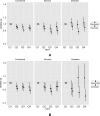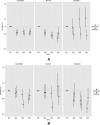Greenness and job-related chronic stress in young adults: a prospective cohort study in Germany
- PMID: 29866734
- PMCID: PMC5988169
- DOI: 10.1136/bmjopen-2018-021599
Greenness and job-related chronic stress in young adults: a prospective cohort study in Germany
Abstract
Objectives: We aimed to prospectively study the association between normalised difference vegetation index (NDVI) as a measure of greenness around homes and occupational stress.
Setting: A population-based cohort in Munich and Dresden cities was followed from age 16-18 years to age 20-23 years (n=1632).
Participants: At baseline, all participants attended high-school while at follow-up some had started working and others studying at university. At baseline and in each follow-up, we assigned NDVI based on participants' residential geocoded addresses and categorised it by quartiles.
Outcome measures: School-related, university-related or job-related self-reported chronic stress was assessed at the two follow-ups by the Trier Scale for Assessment of Chronic Stress using work discontent and work overload as outcomes. We modelled the association employing ordinal generalised estimating equations model accounting for changes in sociodemographics, non-job-related stress, job history and environmental covariates. Stratified analysis by each city was performed.
Results: NVDI at baseline was higher for participants from Dresden (median=0.36; IQR 0.31-0.41) than Munich (0.31; 0.26-0.34). At follow-up, it decreased only for participants in Dresden (0.34; 0.30-0.40). Higher greenness (quartile 4 vs quartile 1) was associated with less work discontent (OR 0.89; 95% CI 0.80 to 0.99) and less work overload (OR 0.87; 95% CI 0.78 to 0.96). In stratified analyses, results were more consistent for Munich than for Dresden.
Conclusions: Our results suggest that residential green spaces, using the vegetation index as a proxy for exposure, are inversely associated with two types of job-related chronic stress in German young adults transitioning from school to university or working life.
Keywords: generalized estimation equations; greenness; job stress; multiple imputation; ndvi; prospective study.
© Article author(s) (or their employer(s) unless otherwise stated in the text of the article) 2018. All rights reserved. No commercial use is permitted unless otherwise expressly granted.
Conflict of interest statement
Competing interests: None declared.
Figures



Similar articles
-
Chronic Stress in Young German Adults: Who Is Affected? A Prospective Cohort Study.Int J Environ Res Public Health. 2017 Oct 31;14(11):1325. doi: 10.3390/ijerph14111325. Int J Environ Res Public Health. 2017. PMID: 29088088 Free PMC article.
-
Associations between neighbourhood greenness and asthma in preschool children in Kaunas, Lithuania: a case-control study.BMJ Open. 2016 Apr 11;6(4):e010341. doi: 10.1136/bmjopen-2015-010341. BMJ Open. 2016. PMID: 27067890 Free PMC article.
-
Determinants of residential greenness and its association with prostate cancer risk: A case-control study in Singapore.Environ Res. 2023 Nov 15;237(Pt 2):116903. doi: 10.1016/j.envres.2023.116903. Epub 2023 Aug 18. Environ Res. 2023. PMID: 37598842
-
The association between the incidence of post-menopausal breast cancer and residential greenness.Cancer Epidemiol. 2022 Feb;76:102094. doi: 10.1016/j.canep.2021.102094. Epub 2022 Jan 5. Cancer Epidemiol. 2022. PMID: 34995872
-
The associations of residential greenness with fetal growth in utero and birth weight: A birth cohort study in Beijing, China.Environ Int. 2020 Aug;141:105793. doi: 10.1016/j.envint.2020.105793. Epub 2020 May 14. Environ Int. 2020. PMID: 32417616
Cited by
-
The association between neighborhood greenness and incidence of lethal prostate cancer: A prospective cohort study.Environ Epidemiol. 2020 Apr 9;4(2):e091. doi: 10.1097/EE9.0000000000000091. eCollection 2020 Apr. Environ Epidemiol. 2020. PMID: 32656487 Free PMC article.
-
The Association between Green Space and Adolescents' Mental Well-Being: A Systematic Review.Int J Environ Res Public Health. 2020 Sep 11;17(18):6640. doi: 10.3390/ijerph17186640. Int J Environ Res Public Health. 2020. PMID: 32932996 Free PMC article.
-
A Smartphone App for Improving Mental Health through Connecting with Urban Nature.Int J Environ Res Public Health. 2019 Sep 12;16(18):3373. doi: 10.3390/ijerph16183373. Int J Environ Res Public Health. 2019. PMID: 31547286 Free PMC article.
-
Urban Nature and Public Health: How Nature Exposure and Sociocultural Background Relate to Depression Risk.Int J Environ Res Public Health. 2021 Sep 14;18(18):9689. doi: 10.3390/ijerph18189689. Int J Environ Res Public Health. 2021. PMID: 34574611 Free PMC article.
-
ECO-MIND: enhancing pro-environmental behaviours and mental health through nature contact for urban youth - a research protocol for a multi-country study using geographic ecological momentary assessment and mental models.BMJ Open. 2024 Oct 8;14(10):e083578. doi: 10.1136/bmjopen-2023-083578. BMJ Open. 2024. PMID: 39384232 Free PMC article.
References
-
- Grupp H, Köenig HH, Konnopka A. Cost measurement of mental disorders in Germany. J Ment Health Policy Econ 2014;17:3–8. - PubMed
-
- Nations U. World Urbanization Prospects: The 2014 Revision, Highlights. Population Division, United Nations: Department of Economic and Social Affairs, 2014.
Publication types
MeSH terms
LinkOut - more resources
Full Text Sources
Other Literature Sources
Medical
